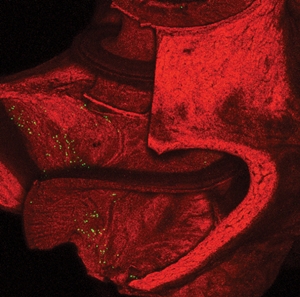
Inside of the cochlea after DNA delivery. The green spots show the location of cells that are expressing the therapeutic gene, which is close to where the cochlear implant electrodes were positioned. (J. Pinyon and G. Housley, UNSW)
24 April 2014. Researchers at University of New South Wales in Sydney, Australia delivered genetic material with electric impulses into cochlear implants that improves the quality of hearing to nearly normal in deaf lab animals. The team led by UNSW’s Gary Housley published its findings in today’s issue of the journal Science Translational Medicine (paid subscription required).
The authors filed two patents for the technology in the U.S., Europe, and Australia. The research was funded in part by Cochlear Ltd., a maker of cochlear implants and other hearing solutions in New South Wales, Australia.
Housley and colleagues addressed a problem of hearing loss affecting millions of people worldwide, particularly older adults where the loss of hearing is a result of degenerating sensory cells. Cochlear implants can restore some the hearing by performing the functions of cochlear hair cells that convert sound waves into electrical nerve signals, sufficient to understand speech. These devices, however, cannot restore more qualitative hearing abilities, such as differentiating musical tones.
The UNSW team devised a system that harnesses the cochlear implant’s ability to translate sound waves into neural impulses, but also stimulates related nerve cells to respond more normally, and thus expand the wearer’s range of hearing functions. The researchers injected DNA containing a gene known as brain-derived neurotrophic factor that generates neurotrophins, proteins promoting survival of nerve cells in the brain, and active in the synapses, or connections, where signaling between nerve cells occurs.
The researchers, however, needed to deliver the gene precisely to the cochlear nerve cells, which is difficult with current gene-therapy methods using benign viruses as the carriers. To overcome this issue, Housley and colleagues employed electrical impulses sent from an array of electrodes attached to the cochlear implant to drive the DNA with brain-derived neurotrophic factor into cochlear nerves.
The team tested the approach with guinea pigs in the lab, induced with total deafness. They measured hearing ability with an auditory brainstem response test, similar to the method used to test hearing in newborn infants. The test involves placing electrodes, in this case, on the guinea pigs’ heads to detect electrical signals in the brain responding to the cochlear nerve fibers stimulated by sounds.
The UNSW team found the guinea pigs receiving the electro-gene therapy registered sharp improvements in hearing ability, including an expanded dynamic range of the cochlear nerve. The hearing abilities of the test animals, report the researchers, were almost completely restored. The tests showed the effects of the treatments wore off in 6 to 10 weeks, suggesting the need for repeated deliveries of the gene.
“Ultimately, we hope that after further research,” says Housley in a university statement, “people who depend on cochlear implant devices will be able to enjoy a broader dynamic and tonal range of sound, which is particularly important for our sense of the auditory world around us and for music appreciation.”
The researchers believe the gene delivery method could also be applied to other neurodegenerative conditions, such as Parkinson’s disease or psychiatric disorders, where deep brain stimulation is supplemented with brain-derived neurotrophic factor. In the following video, the authors tell more about their research.
- Start-Up Developing Gene Therapies Lands $45M in Early Funds
- Mayo Clinic Taking Part in ALS Stem Cell Clinical Trial
- Wireless Sensor System Detects Occurrence of Elderly Falls
- Biopharm Raises $45.9M in Venture Funding for Ear Disorders
- System Analyzes Baby Cries to Detect Development Disorders
* * *

 RSS - Posts
RSS - Posts
You must be logged in to post a comment.